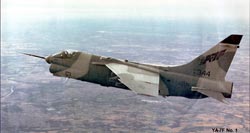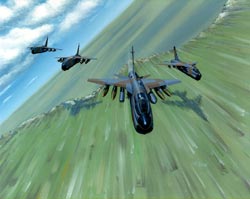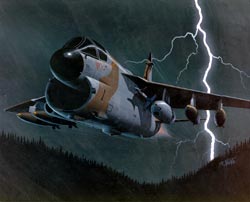|
 In 1985, the. U. S. Air Force Systems Command issued a Request For Information (RFI) for study of the Close Air Support/Battlefield Area Interdiction (CAS/BAI) mission. The U.S. Army and the U.S. Air Force had long been at odds on the subject of close air support for infantry troops and this was yet another chapter in dealing with the problem. The product of the RFI was to be a technical report. In the boldest marketing move ever conceived and executed by the company, the decision was made to respond to the RFI with a proposal for an upgraded version of the A-7. In 1985, the. U. S. Air Force Systems Command issued a Request For Information (RFI) for study of the Close Air Support/Battlefield Area Interdiction (CAS/BAI) mission. The U.S. Army and the U.S. Air Force had long been at odds on the subject of close air support for infantry troops and this was yet another chapter in dealing with the problem. The product of the RFI was to be a technical report. In the boldest marketing move ever conceived and executed by the company, the decision was made to respond to the RFI with a proposal for an upgraded version of the A-7.
 The strategy was to form a marketing "Superteam" which would blitz the customer with a series of presentations featuring the upgraded A-7 as the answer to the CAS/BAI problems, and follow that with a proposal for the airplane. Division President, Phil Greco, a leader with a marketing flare and the courage to attempt the near-impossible, commissioned a blue ribbon group to perform the program. Led by A-7 Engineering Director Betty Pearce, the top woman executive in the aerospace industry, the team launched into a marketing effort that found no peer. After a series of presentations to USAF leaders all over the world, and the submission of an unsolicited proposal to the Air Systems Command, a contract (N33657-87-C-011) was awarded for two prototype airplanes designated the YA-7F. The strategy was to form a marketing "Superteam" which would blitz the customer with a series of presentations featuring the upgraded A-7 as the answer to the CAS/BAI problems, and follow that with a proposal for the airplane. Division President, Phil Greco, a leader with a marketing flare and the courage to attempt the near-impossible, commissioned a blue ribbon group to perform the program. Led by A-7 Engineering Director Betty Pearce, the top woman executive in the aerospace industry, the team launched into a marketing effort that found no peer. After a series of presentations to USAF leaders all over the world, and the submission of an unsolicited proposal to the Air Systems Command, a contract (N33657-87-C-011) was awarded for two prototype airplanes designated the YA-7F.
 The principal feature of the YA-7F was incorporation of the Pratt & Whitney F100-PW-220 afterburning engine of 20,000 pounds thrust. This required structural modification of the fuselage to add 29.5 inches just forward of the wing, 18 inches immediately aft of the wing and upward rotation of the fuselage aft section to maintain ground clearance. Wing strakes were also added. Other equipment provided was a 60-KVA generator, an On-Board Oxygen Generating System (OBOGS), and revised cockpit controls and displays. Many other improvements were made throughout the airplane The principal feature of the YA-7F was incorporation of the Pratt & Whitney F100-PW-220 afterburning engine of 20,000 pounds thrust. This required structural modification of the fuselage to add 29.5 inches just forward of the wing, 18 inches immediately aft of the wing and upward rotation of the fuselage aft section to maintain ground clearance. Wing strakes were also added. Other equipment provided was a 60-KVA generator, an On-Board Oxygen Generating System (OBOGS), and revised cockpit controls and displays. Many other improvements were made throughout the airplane
The YA-7F first flew in November 1989 with test pilot Jim Read at the controls. Vought proposed to modify 307 Air National Guard A-7D's to the A-7F configuration at a unit flyaway cost of $4.93 million. The two prototypes went on to complete a very successful flight test program at Edwards Air Force Base, but the USAF chose not to put the airplane into production.
A-7:
Genesis of the Navy Attack Bomber, Light (VA(L))
In Comat
Farewell Proud Bird
Aircraft Performance Perspective
|